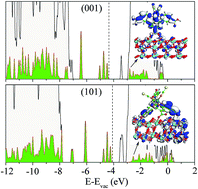First principles study of ruthenium(ii) sensitizer adsorption on anatase TiO2 (001) surface†
Abstract
We present a systematic investigation of the adsorption behavior of the highly efficient ruthenium(II) sensitizer (N3) on the anatase TiO2 (001) surface based on density functional theory. Three preferable configurations can be formed by exploiting two or three carboxylic groups attached to the TiO2 surface, with their adsorption energies differing slightly. The interplay of N3 with the (001) surface is considerably stronger than that of N3 with the (101) surface, resulting in a larger dye coverage on the (001) surface. The energy gap of the N3 sensitizer, determining the absorption spectrum, decreases about 0.12 eV upon adsorption, suggesting an even larger range for the absorption spectrum than for the isolated N3 molecule. Moreover, the higher conduction band minimum of the TiO2 (001) surface with N3 adsorption, compared with that of the (101) surface, indicates the higher open circuit potential. These results provide a clue to understand the high solar light-to-electricity conversion efficiency of dye sensitized solar cells with TiO2 nanocrystals exposing a high percentage of {001} faces.


 Please wait while we load your content...
Please wait while we load your content...